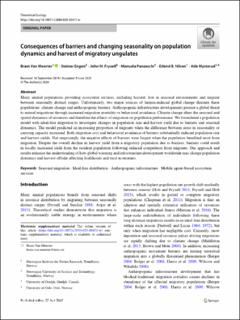| dc.contributor.author | Van Moorter, Bram | |
| dc.contributor.author | Engen, Steinar | |
| dc.contributor.author | Fryxell, John M. | |
| dc.contributor.author | Panzacchi, Manuela | |
| dc.contributor.author | Nilsen, Erlend Birkeland | |
| dc.contributor.author | Mysterud, Atle | |
| dc.date.accessioned | 2020-08-19T07:46:48Z | |
| dc.date.available | 2020-08-19T07:46:48Z | |
| dc.date.created | 2020-08-12T13:47:26Z | |
| dc.date.issued | 2020 | |
| dc.identifier.issn | 1874-1738 | |
| dc.identifier.uri | https://hdl.handle.net/11250/2672909 | |
| dc.description.abstract | Many animal populations providing ecosystem services, including harvest, live in seasonal environments and migrate between seasonally distinct ranges. Unfortunately, two major sources of human-induced global change threaten these populations: climate change and anthropogenic barriers. Anthropogenic infrastructure developments present a global threat to animal migrations through increased migration mortality or behavioral avoidance. Climate change alters the seasonal and spatial dynamics of resources and therefore the effects of migration on population performance. We formulated a population model with ideal-free migration to investigate changes in population size and harvest yield due to barriers and seasonal dynamics. The model predicted an increasing proportion of migrants when the difference between areas in seasonality or carrying capacity increased. Both migration cost and behavioral avoidance of barriers substantially reduced population size and harvest yields. Not surprisingly, the negative effects of barriers were largest when the population benefited most from migration. Despite the overall decline in harvest yield from a migratory population due to barriers, barriers could result in locally increased yield from the resident population following reduced competition from migrants. Our approach and results enhance the understanding of how global warming and infrastructure development worldwide may change population dynamics and harvest offtake affecting livelihoods and rural economies. Seasonal migration · Ideal-free distribution · Anthropogenic infrastructure · Mobile agent–based ecosystem services | en_US |
| dc.language.iso | eng | en_US |
| dc.publisher | Elsevier | en_US |
| dc.rights | Navngivelse 4.0 Internasjonal | * |
| dc.rights.uri | http://creativecommons.org/licenses/by/4.0/deed.no | * |
| dc.title | Consequences of barriers and changing seasonality on population dynamics and harvest of migratory ungulates | en_US |
| dc.type | Peer reviewed | en_US |
| dc.type | Journal article | en_US |
| dc.description.version | publishedVersion | en_US |
| dc.subject.nsi | VDP::Zoologiske og botaniske fag: 480 | en_US |
| dc.subject.nsi | VDP::Zoology and botany: 480 | en_US |
| dc.source.journal | Theoretical Ecology | en_US |
| dc.identifier.doi | https://doi.org/10.1007/s12080-020-00471-w | |
| dc.identifier.cristin | 1822997 | |
| dc.relation.project | Norges forskningsråd: 251112 | en_US |
| dc.relation.project | Norges forskningsråd: 230335 | en_US |
| dc.relation.project | Norges forskningsråd: 255635/E50 | en_US |
| dc.description.localcode | © The Author(s) 2020. This article is licensed under a Creative Commons Attribution 4.0 International License, which permits use, sharing, adaptation, distribution and reproduction in any medium or format, as long as you give appropriate credit to the original author(s) and the source, provide a link to the Creative Commons licence, and indicate if changes were made. The images or other third party material in this article are included in the article’s Creative Commons licence, unless indicated otherwise in a credit line to the material. If material is not included in the article’s Creative Commons licence and your intended use is not permitted by statutory regulation or exceeds the permitted use, you will need to obtain permission directly from the copyright holder. To view a copy of this licence, visit http:// creativecommonshorg/licenses/by/4.0/. | en_US |
| cristin.ispublished | true | |
| cristin.fulltext | original | |
| cristin.qualitycode | 1 | |

